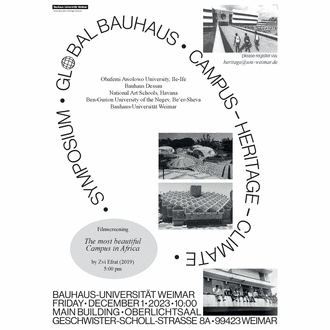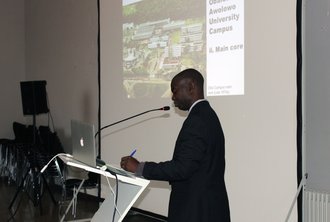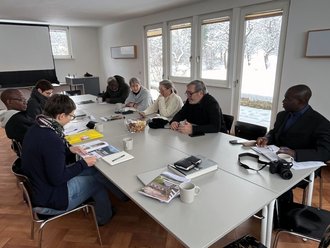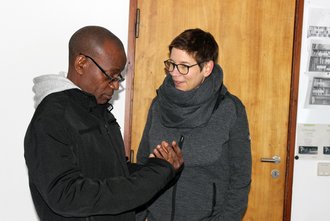Neuigkeiten am Internationalen Heritage-Zentrum






Review: Global Bauhaus Symposium
The symposium 'Global Bauhaus: Campus - Heritage - Climate', held at the Bauhaus University in Weimar on December 1, 2023, was dedicated to discussing 20th century university buildings and campuses that are closely linked to the concepts of Neues Bauen. The challenges that arise from the complex interrelationships between the architectural-historical evaluation, construction technology and climatic conditions were examined through diverse built examples from across the world.
The focal point of the symposium was the Obafemi Awolowo University in Ile-Ife, Nigeria. Designed by Arieh Sharon and built between 1962 and 1976, it was the first university after Nigerian independence. The university buildings are representative of the international Bauhaus style, but have been adapted to the local environment and incorporate traditional Nigerian elements. In response to the tropical climate, open spaces and courtyards alternate to support natural ventilation, while increasing cantilevers create a striking inverted pyramid shape. Architect Adekunle Olusola Adeyemo's presentation, which gave an overview of the campus, opened the morning session of the symposium. As part of the Getty Keep-It-Modern 2020 Conservation Management Plan and supported by the Gerda Henkel Foundation, his doctoral research project explored the significance of the campus on aesthetic, environmental, political and socio-cultural levels.
The symposium then shifted its focus to Cuba, as Michael Siebenbrodt, an architect and freelance architectural historian, presented the National Arts School (ENA, 1960-1963) and the Jose Antonio Echeverria Polytechnic Institute (CUJAE - 1961 - 1964) in Havana. These two projects embody the ideas and aspirations of the early years of the revolution in contrasting built forms. The spaces for dance, music, and visual arts were designed by Cuban architect Ricardo Porro and his Italian colleagues Roberto Gottardi and Vittorio Garatti, featuring brick and terracotta vaulted structures that trace the undulating contours of the former golf course. Never completed, the campus was soon abandoned, leading to its current state of progressive decay. Its organic design stands in stark contrast to the buildings of the CUJAE campus, which are mainly made of exposed concrete arranged in an orthogonal grid. The buildings are raised on pilots above the landscape, connected by covered walkways and still in use today.
Zvi Efrat, partner at Efrat-Kowalsky Architects and professor of architecture at the Bezalel Academy of Arts and Design in Jerusalem, concluded the morning with a presentation on the Ben-Gurion University of the Negev in Be'er Sheva, Israel. The architectural experiments of the late 1950s in the Negev desert were created by a group of young Israeli architects. Influenced by the government's decision to use the latest construction technologies to enable rapid and cost-effective building on a large scale, visions of the future city were realised in reinforced concrete in the form of brutalism.
The afternoon session started with a presentation by Dorothea Roos, an architect and researcher currently heading the building department at Bauhaus Dessau. She deliberated on the challenges posed by climate change concerning the conservation of the Bauhaus ensemble in Dessau, Germany. Her presentation covered monitoring structural modifications and diverse experimentation with novel strategies to adapt the buildings to changing environmental conditions.
Returning to the OAU Campus in Ile-Ife, Architect and Professor of Architecture at the Obafemi Awolowo University, Emmanuel Babatunde Jaiyeoba explored the climatic and conservational aspects that the campus endured during the times since its construction. The analysis highlighted the dynamic interplay between environmental factors, user requirements and deliberate design choices that have influenced the campus over the years. Changes range from spontaneous adaptations made by users in response to growing student numbers, to the planned expansion of the campus with explicit design references to the Sharon campus.
Daniela Spiegel, Professor at the Chair of Conservation and Architectural History at the Bauhaus-University Weimar, addressed the issues encountered by the Bauhaus campus in Weimar as a living centre and a world cultural heritage site in her closing lecture at the symposium. The university buildings (built between 1904-1911) designed by Henry Van de Velde with Art Nouveau elements are representative of the beginnings of modernism, the combination of art and industry, and the founding of the Bauhaus. The insightful discussion therefore emphasised the need for a delicate balance between conservation and functionality, as well as the role of the campus in nurturing the education of the next generation of architects and designers.
The symposium concluded with a screening of the documentary film 'The Most Beautiful Campus in Africa' (2019), directed by Zvi Efrat and commissioned by the ‘Bauhaus Imaginista’ exhibition programme. A discussion with the filmmaker and Samuel Adebayo Amole, an emeritus professor at Obafemi Awolowo University and one of the film's protagonists, followed. The film highlighted the range of indoor and outdoor spaces on campus that support the academic and recreational activities of the university community, from quiet reading areas to spaces for spontaneous celebrations. This adaptive utilisation of spaces vividly illustrates the difficulties of protecting listed architecture, which derives part of its significance from its individual use, and thus from an aspect that can only be preserved through continuous living practice. Accordingly, the ensuing debate at the symposium focussed on aspects of tangible and intangible heritage, and the balance between safeguarding the built fabric and the dynamic activities commonly found in contemporary university campuses. The question of the possible benefits and drawbacks of a listing status for university buildings was a central issue that cannot be answered in general terms. Nevertheless, the heritage of universities, which has been undervalued up to this point, can undoubtedly demonstrate its significance to the general public and enhance awareness among users by attaining listing status.
The following day, representatives from four institutions - Bauhaus University Weimar, Bauhaus Dessau Foundation, Bezalel Academy Jerusalem and Obafemi Awolowo University - met for an internal workshop to discuss possibilities for future collaboration.
The organisers would like to thank the Executive Board of the Bauhaus-University Weimar for the generous support of the symposium from the Jubilee Fund for "100 Years of Bauhaus".
